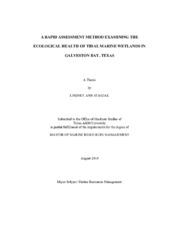| dc.description.abstract | Wetlands are one of the most productive ecosystems in the world, housing diverse biota and serving important functions as nursery habitat and feeding grounds. However, nearly 70% of coastal wetlands, including 21% of the salt marshes in Texas, have been lost since 1950, due primarily to coastal development and declines in water quality. Restoration of wetlands is essential to reestablish lost functions, but there is no standard method to assess the ecological health of restored salt marshes in Texas. Numerous recent salt marsh restoration projects in Galveston Bay have made it an ideal model system to develop and implement an ecosystem health assessment, known as a rapid assessment method (RAM). In this study, I modified an established RAM, the Mid-Atlantic Tidal Fringe Assessment, to compare the ecological health of representative reference salt marshes to restored marshes around Galveston Bay.
I measured 14 biotic and abiotic characteristics at 12 restored and 6 reference sites around Galveston Bay, and then grouped those measurements into four functional groups: landscape/site characteristics, hydrology, wildlife habitat, and soil characteristics. I then developed a scoring system (minimum 0, maximum 100) to summarize the overall health of each site.
Most of the restored salt marshes in this study scored lower than reference marshes. The average reference site score was 81.8 and the average restored site score was 69.7. Functional group values for landscape/site characteristics, soil, and wildlife habitat were significantly lower in restored than in reference sites. In particular, restored sites had more hydrological modifications, more fill material, and fewer macrobenthos than reference wetlands.
The Galv-RAM effectively and efficiently identified restoration successes and weaknesses. With this information, management agencies can address restoration shortcomings by adapting management goals. The Galv-RAM will streamline monitoring protocols and facilitate long-term examination of restored wetland health. As a result, management decisions can be modified based on the scores received in different categories or variables to improve and or meet the goals of the project. | en |


